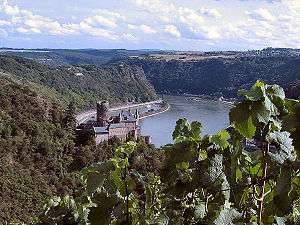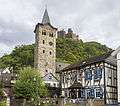Sankt Goarshausen
| Sankt Goarshausen | ||
|---|---|---|
 | ||
| ||
 Sankt Goarshausen | ||
Location of Sankt Goarshausen within Rhein-Lahn-Kreis district  | ||
| Coordinates: 50°9′17″N 7°42′55″E / 50.15472°N 7.71528°ECoordinates: 50°9′17″N 7°42′55″E / 50.15472°N 7.71528°E | ||
| Country | Germany | |
| State | Rhineland-Palatinate | |
| District | Rhein-Lahn-Kreis | |
| Municipal assoc. | Loreley | |
| Government | ||
| • Mayor | Bernhard Roth (CDU) | |
| Area | ||
| • Total | 7.00 km2 (2.70 sq mi) | |
| Population (2013-12-31)[1] | ||
| • Total | 1,306 | |
| • Density | 190/km2 (480/sq mi) | |
| Time zone | CET/CEST (UTC+1/+2) | |
| Postal codes | 56346 | |
| Dialling codes | 06771 | |
| Vehicle registration | EMS, DIZ, GOH | |
| Website | www.sankt-goarshausen.de | |
Sankt Goarshausen (abbreviated St. Goarshausen) is a town located in the Rhein-Lahn-Kreis in Nassau on the eastern shore of the Rhine, in the section known as the Rhine Gorge, directly across the river from Sankt Goar, in the German state Rhineland-Palatinate. It is located within the Nassau Nature Park and the Rhine Gorge UNESCO world heritage site, and was historically part of the Duchy of Nassau. It lies approximately 30 km south of Koblenz, and it is above all famous for the Lorelei rock nearby. Sankt Goarshausen is the seat of the Loreley collective municipality. The town's economy is based on wine making and tourism.
The Sankt Goarshausen railway station connects the town with Wiesbaden, Frankfurt and Koblenz. Sankt Goarshausen was formerly the terminus of the Nassau Light Railway line between Sankt Goarshausen and Nastätten.
History
In 1885, St. Goarshausen had almost 1,456 inhabitants. Close to the town in the hillside just above it, lie the ruins of 14th century Castle Katz, ruined since 1806.
Demographics
Around 50% of the population are Protestants, while around 30% are Catholics. Sankt Goarshausen had a small Jewish community from the 17th century to the 1930s, peaking at 2,4 % in 1895.[2]
Economy

The town has 1,585 inhabitants as of December 31, 2002, and is the seat of the township association (Verbandsgemeinde) Loreley. With the villages Ehrental, Wellmich and Heide, the number of inhabitants is over 2,000.
The most important economic areas for St. Goarshausen are tourism and wine making. In earlier times was the town an important place along the Rhein for fishing and as an embarcation area. Today, the formerly very busy town is losing its importance and relies more and more on tourism. Especially problematic for St. Goarshausen is the short distance to the larger city Nastätten, that has replaced St. Goarshausen as the regional centre.
In tourism, the biggest competitor is the twin city St. Goar on the other shore of the Rhine. St. Goar is only reachable by ferry, as the closest bridge is 30 km away. While there is an established need for a bridge across the Rhine, plans for connecting the towns have not yet been realised.
To help tourism, a visitors centre has been established in connection to the Lorelei rock.
Sights
The most famous point in town, that also brings the most tourists is the site of the Lorelei rock.
In St. Goarshausen there are two castles, Burg Katz (English: Castle Cat, formerly Burg Neu-Katzenelnbogen) and Burg Maus (English: Castle Mouse). Burg Katz is not open for visitors. There is a good view over the town from Burg Maus, and also visible are the ruins of Burg Rheinfels on the other side of Rhine.
Recurring events
- The third weekend of September: Rhein in Flammen, large fireworks from Burg Katz in St. Goarshausen, Burg Rheinfels in St. Goar and from the middle of the Rhine.
Gallery
-

View of St. Goarshausen
-
Burg Katz, above St. Goarshausen
-

St. Goarshausen, by Thomas M Richardson
-

Loreley Rock
-

St. Goarshausen
-

St.Goarshausen
-

Castle Katz
-

Secthaus St.Goarshausen
-

St.Goarshausen - Wellmich
-

St.Goarshausen - Wellmich
-

Castle Rheinfels
References
- ↑ "Gemeinden in Deutschland mit Bevölkerung am 31. Dezember 2013". Statistisches Bundesamt (in German). 2014.
- ↑ Sankt Goarshausen, Alemannia Judaica
External links
- (German) About Verbandsgemeinde Loreley, with map
- St. Goarshausen Loreley City
|

